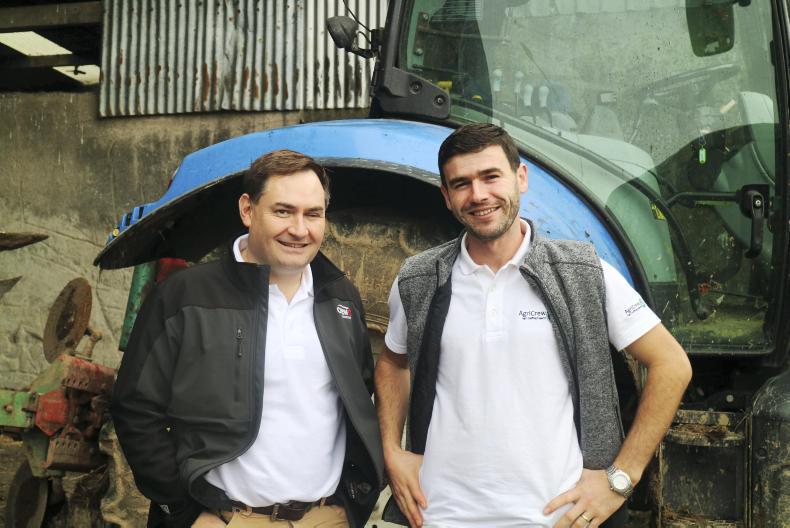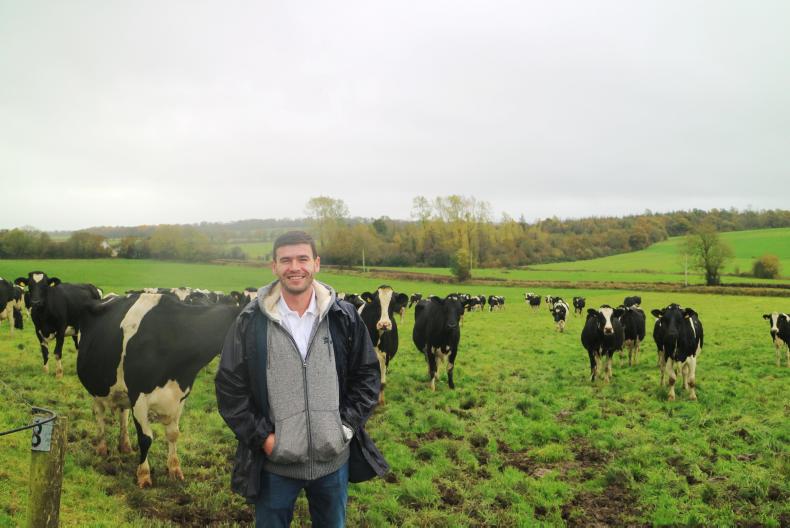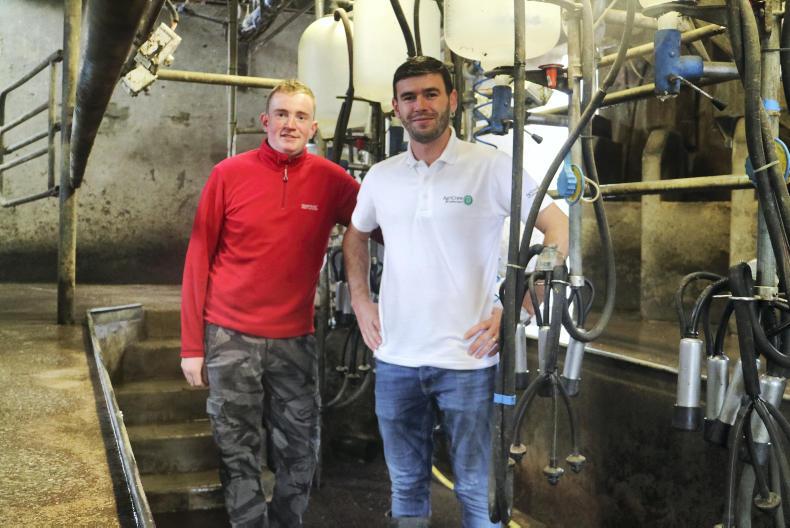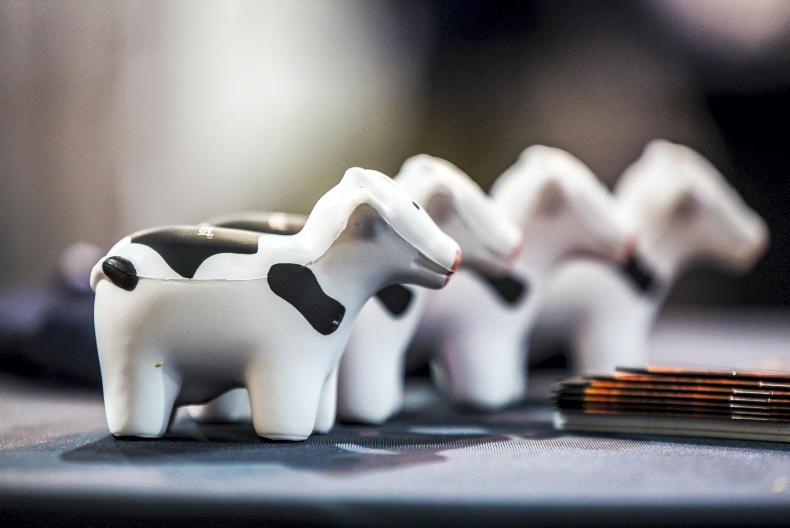The challenge of recruiting people to work on dairy farms will no doubt rear its head again as we approach the busy spring-calving period. Two years ago it was estimated that there would be over 6,000 additional people needed in the dairy industry between 2016 and 2025, just to meet staffing needs and regeneration on farms.
While the increase in cow numbers is easing, demand for labour is still quite strong. The 2017 Moorepark report, The People in Dairy Project, identified a need for farmers to be upskilled in staff management as well as encouraging more Irish people to consider work on dairy farms and potentially source more employees from abroad. Of the career opportunities in dairy farming, Teagasc estimate 2,000 are employed jobs on farms, 4,000 are those where the older generation of farmers are looking to step back.
Listen to "Addressing the dairy labour challenge" on Spreaker.
“There are 40 actions recommended in the People in Dairy action plan. A number of them are progressing well, but some of the newer initiatives are slower to get off the ground than I initially hoped. One of the actions was to hire a programme manager but there hasn’t been one taken on yet,” said Paidi Kelly, the lead author on the report.
The idea there is to attract a more practical-minded student that doesn’t want to go to ag college for two years
“The work permit development has been a big part of it. Another part of attracting new people is dairy farming apprenticeships, Teagasc will launch a course in that next September. The idea there is to attract a more practical-minded student that doesn’t want to go to ag college for two years.”
One of the other actions taken since the report was published was the launch of the Farm Relief Service’s 20-day course introducing people to milking skills in partnership with Teagasc.
Two new research programmes have also started in Teagasc. One of them sees a group of 80 dairy farmers tracking the number of hours worked on farm and what tasks take the most time. The other research programme is around human resources (HR) practices on farm and how farmers can become better employers.
Training
Teagasc has started doing a four-day HR management and training course in autumn for farmers.
“The Macra land mobility service is also part of addressing the career pathways into farming, they’ve recruited two more people since that report.” CL
The Department of Business, Skills and Innovation, created a pilot scheme that granted permits to non-EEA workers. There was a quota of 250 permits for meat factory workers initially, but this was quickly filled and more permits were made available. However, the 1,500 permits available have now been used. Sources in the meat industry suggest that there are indications more permits will be made available shortly.
Of the 150 permits made available for dairy workers, some 86 (57%) have been granted. Of those, 20% went to Ukrainian citizens and 20% to Indian citizens.
Irish Country Living set out to hear the views of those working in the coalface of recruitment.
Gary O’Keeffe started out his career as a farm labourer, milking cows for his neighbours in Laois. He has worked in recruitment since the late 90s and is now managing director of Crewit. The company has offices in Dublin, London and Kosovo where it is currently recruiting staff to come to Ireland.
When a farmer approaches Crewit for staff, there is no up-front charge, Gary says. There is a €1,000 charge for the work permit. On top of that the farmer pays a once-off €2,500 plus VAT to Crewit one month after the worker arrives on farm. Gary added that Crewit gives a three-month guarantee of your money back if it does not work out. The Department of Business specifies that the minimum wage for dairy workers on a non-EEA worker permit is €22,000 minimum for a 39-hour week.
ICL: Why are you recruiting workers from Kosovo?
Gary: Being an international recruitment agency, you can recruit people from anywhere. But there is no point recruiting people that don’t match the skills. So we investigated a lot of countries and when we went to Kosovo we found people with small [mixed] farms, a little bit of dairying and a little bit of arable. More importantly they had a decent level of English and a culture that was very similar to ours in their understanding of rural life and family values.
How many people has Crewit recruited from Kosovo so far?
We have about 60 people on the ground and we know we have close to 200 people going through the application process at the minute. There’s no point in saying anything else, the process is very arduous. There are two steps to it; the first is the work permit itself and that can take anything from 12 to 16 weeks.

Gary O'Keeffe from Bluestone facilities with Agon Krasniqi from Kosovo. \ Odile Evans
The next step is you need to get a visa. The work permit gets physically sent to our office in Kosovo with all of the employment contracts and all the documentation. Then we need to apply for a visa through the Department of Business. That takes quite a bit of time, it’s very complicated because Kosovo is a new country. We have to send the application to a consulate in Belgrade who then send it to the Irish embassy in Budapest and then reverse the journey. It seems incredible, but to get the visa can take anything between eight and 12 weeks.
So, a farmer needs to come to you five months ahead of when they need a worker?
Definitely. There are situations where we’ve got it done in four months. But generally we’re talking anything from four to six months. It does require quite a bit of planning.
With your experience over the years, give us an overview of what the European labour crisis means for Irish farmers.
If you think back to 1999, I was involved in recruiting people from eastern Europe which was generally the saviour of Ireland because people were in emerging economies there. All that has completely changed. All those what you might call ‘feeder countries’ have developed economically, unemployment levels have dropped and they are now facing net immigration themselves. They are no longer a source of labour for the EU.
So for international labour we’re having to go further afield, maybe more eastern depending on the level of salary and skill. It’s more and more difficult to get a match of skills for dairying. Kosovo is one of the pots of gold in terms of skill. But we’ve gone as far as Kirghizstan, Uzbekistan, we’ve been down in South America in Bolivia and other countries that are further back on this economic curve.
In 10 years’ time where will we be recruiting labour from?
You’ll be talking about central Asia and South America.
Is language a barrier?
Some people will make language more of a barrier than it is. In fact, psychologists will tell you that only 7% of communication is around words, 80% of it is around body language. What we’re trying to do is make the transition easier. So in Kosovo when we have people selected, they go in to a 12-week 120-hour language training programme. Remember, moving country and leaving family is very stressful, so the least amount of barriers possible is important. Training is everything.
Agon Krasniqi, Mallow, Co Cork
Agon Krasniqi (28) moved from Kosovo to Cork in June 2019. He is working and living on the farm of Laurence and John O’Donoghue, just outside Mallow. They are milking approximately 85 cows and have 200 acres of tillage.
“I wanted to see how Ireland works. It is a nice country, but a lot of rain. In Kosovo everyone has a small farm, but only to feed the family.

Agon Krasniqi from Kosovo on the farm of Laurence and John O'Donoghue outside Mallow, Co Cork. \ Odile Evans
“It is a small country of 1.8 million people and it is expensive to buy land (€50,000/ha). My home farm has 1ha of maize, 1ha of wheat and 1ac of raspberries where I hope to plant walnut trees also.
“I am married, but I wanted to try a different life, my wife will come to visit. I knew Hectori (recruiter) in the Crewit (see page 20) office in Kosovo and he asked me if I wanted to go to Ireland. I applied in November for my permit and it took five months.
“I learnt English in movies and songs. There was a war in Kosovo from 1997 to 1999 and for three years we did not go to school.

Agon Krasniqi and John O'Donoghue. \ Odile Evans
“Farming in Ireland is a big change, the equipment is bigger and the fields are bigger. A Massey 135 is common in Kosovo. When I came here, I was drawing a 23t trailer of wheat. “At home we have one cow and one heifer with a bucket plant. So I know how to fix a pump for example. I was ploughing for the first time in November this year and am learning how to use the diet feeder.
“To other people coming from Kosovo I would say that they need to learn about cows before coming. You have to be quiet with cows and not make fast moves. You also need to learn which cows are slow or fast and see how they get treated for mastitis.”
Read more
Dairy Day: study options for dairy farming
The challenge of recruiting people to work on dairy farms will no doubt rear its head again as we approach the busy spring-calving period. Two years ago it was estimated that there would be over 6,000 additional people needed in the dairy industry between 2016 and 2025, just to meet staffing needs and regeneration on farms.
While the increase in cow numbers is easing, demand for labour is still quite strong. The 2017 Moorepark report, The People in Dairy Project, identified a need for farmers to be upskilled in staff management as well as encouraging more Irish people to consider work on dairy farms and potentially source more employees from abroad. Of the career opportunities in dairy farming, Teagasc estimate 2,000 are employed jobs on farms, 4,000 are those where the older generation of farmers are looking to step back.
Listen to "Addressing the dairy labour challenge" on Spreaker.
“There are 40 actions recommended in the People in Dairy action plan. A number of them are progressing well, but some of the newer initiatives are slower to get off the ground than I initially hoped. One of the actions was to hire a programme manager but there hasn’t been one taken on yet,” said Paidi Kelly, the lead author on the report.
The idea there is to attract a more practical-minded student that doesn’t want to go to ag college for two years
“The work permit development has been a big part of it. Another part of attracting new people is dairy farming apprenticeships, Teagasc will launch a course in that next September. The idea there is to attract a more practical-minded student that doesn’t want to go to ag college for two years.”
One of the other actions taken since the report was published was the launch of the Farm Relief Service’s 20-day course introducing people to milking skills in partnership with Teagasc.
Two new research programmes have also started in Teagasc. One of them sees a group of 80 dairy farmers tracking the number of hours worked on farm and what tasks take the most time. The other research programme is around human resources (HR) practices on farm and how farmers can become better employers.
Training
Teagasc has started doing a four-day HR management and training course in autumn for farmers.
“The Macra land mobility service is also part of addressing the career pathways into farming, they’ve recruited two more people since that report.” CL
The Department of Business, Skills and Innovation, created a pilot scheme that granted permits to non-EEA workers. There was a quota of 250 permits for meat factory workers initially, but this was quickly filled and more permits were made available. However, the 1,500 permits available have now been used. Sources in the meat industry suggest that there are indications more permits will be made available shortly.
Of the 150 permits made available for dairy workers, some 86 (57%) have been granted. Of those, 20% went to Ukrainian citizens and 20% to Indian citizens.
Irish Country Living set out to hear the views of those working in the coalface of recruitment.
Gary O’Keeffe started out his career as a farm labourer, milking cows for his neighbours in Laois. He has worked in recruitment since the late 90s and is now managing director of Crewit. The company has offices in Dublin, London and Kosovo where it is currently recruiting staff to come to Ireland.
When a farmer approaches Crewit for staff, there is no up-front charge, Gary says. There is a €1,000 charge for the work permit. On top of that the farmer pays a once-off €2,500 plus VAT to Crewit one month after the worker arrives on farm. Gary added that Crewit gives a three-month guarantee of your money back if it does not work out. The Department of Business specifies that the minimum wage for dairy workers on a non-EEA worker permit is €22,000 minimum for a 39-hour week.
ICL: Why are you recruiting workers from Kosovo?
Gary: Being an international recruitment agency, you can recruit people from anywhere. But there is no point recruiting people that don’t match the skills. So we investigated a lot of countries and when we went to Kosovo we found people with small [mixed] farms, a little bit of dairying and a little bit of arable. More importantly they had a decent level of English and a culture that was very similar to ours in their understanding of rural life and family values.
How many people has Crewit recruited from Kosovo so far?
We have about 60 people on the ground and we know we have close to 200 people going through the application process at the minute. There’s no point in saying anything else, the process is very arduous. There are two steps to it; the first is the work permit itself and that can take anything from 12 to 16 weeks.

Gary O'Keeffe from Bluestone facilities with Agon Krasniqi from Kosovo. \ Odile Evans
The next step is you need to get a visa. The work permit gets physically sent to our office in Kosovo with all of the employment contracts and all the documentation. Then we need to apply for a visa through the Department of Business. That takes quite a bit of time, it’s very complicated because Kosovo is a new country. We have to send the application to a consulate in Belgrade who then send it to the Irish embassy in Budapest and then reverse the journey. It seems incredible, but to get the visa can take anything between eight and 12 weeks.
So, a farmer needs to come to you five months ahead of when they need a worker?
Definitely. There are situations where we’ve got it done in four months. But generally we’re talking anything from four to six months. It does require quite a bit of planning.
With your experience over the years, give us an overview of what the European labour crisis means for Irish farmers.
If you think back to 1999, I was involved in recruiting people from eastern Europe which was generally the saviour of Ireland because people were in emerging economies there. All that has completely changed. All those what you might call ‘feeder countries’ have developed economically, unemployment levels have dropped and they are now facing net immigration themselves. They are no longer a source of labour for the EU.
So for international labour we’re having to go further afield, maybe more eastern depending on the level of salary and skill. It’s more and more difficult to get a match of skills for dairying. Kosovo is one of the pots of gold in terms of skill. But we’ve gone as far as Kirghizstan, Uzbekistan, we’ve been down in South America in Bolivia and other countries that are further back on this economic curve.
In 10 years’ time where will we be recruiting labour from?
You’ll be talking about central Asia and South America.
Is language a barrier?
Some people will make language more of a barrier than it is. In fact, psychologists will tell you that only 7% of communication is around words, 80% of it is around body language. What we’re trying to do is make the transition easier. So in Kosovo when we have people selected, they go in to a 12-week 120-hour language training programme. Remember, moving country and leaving family is very stressful, so the least amount of barriers possible is important. Training is everything.
Agon Krasniqi, Mallow, Co Cork
Agon Krasniqi (28) moved from Kosovo to Cork in June 2019. He is working and living on the farm of Laurence and John O’Donoghue, just outside Mallow. They are milking approximately 85 cows and have 200 acres of tillage.
“I wanted to see how Ireland works. It is a nice country, but a lot of rain. In Kosovo everyone has a small farm, but only to feed the family.

Agon Krasniqi from Kosovo on the farm of Laurence and John O'Donoghue outside Mallow, Co Cork. \ Odile Evans
“It is a small country of 1.8 million people and it is expensive to buy land (€50,000/ha). My home farm has 1ha of maize, 1ha of wheat and 1ac of raspberries where I hope to plant walnut trees also.
“I am married, but I wanted to try a different life, my wife will come to visit. I knew Hectori (recruiter) in the Crewit (see page 20) office in Kosovo and he asked me if I wanted to go to Ireland. I applied in November for my permit and it took five months.
“I learnt English in movies and songs. There was a war in Kosovo from 1997 to 1999 and for three years we did not go to school.

Agon Krasniqi and John O'Donoghue. \ Odile Evans
“Farming in Ireland is a big change, the equipment is bigger and the fields are bigger. A Massey 135 is common in Kosovo. When I came here, I was drawing a 23t trailer of wheat. “At home we have one cow and one heifer with a bucket plant. So I know how to fix a pump for example. I was ploughing for the first time in November this year and am learning how to use the diet feeder.
“To other people coming from Kosovo I would say that they need to learn about cows before coming. You have to be quiet with cows and not make fast moves. You also need to learn which cows are slow or fast and see how they get treated for mastitis.”
Read more
Dairy Day: study options for dairy farming













SHARING OPTIONS